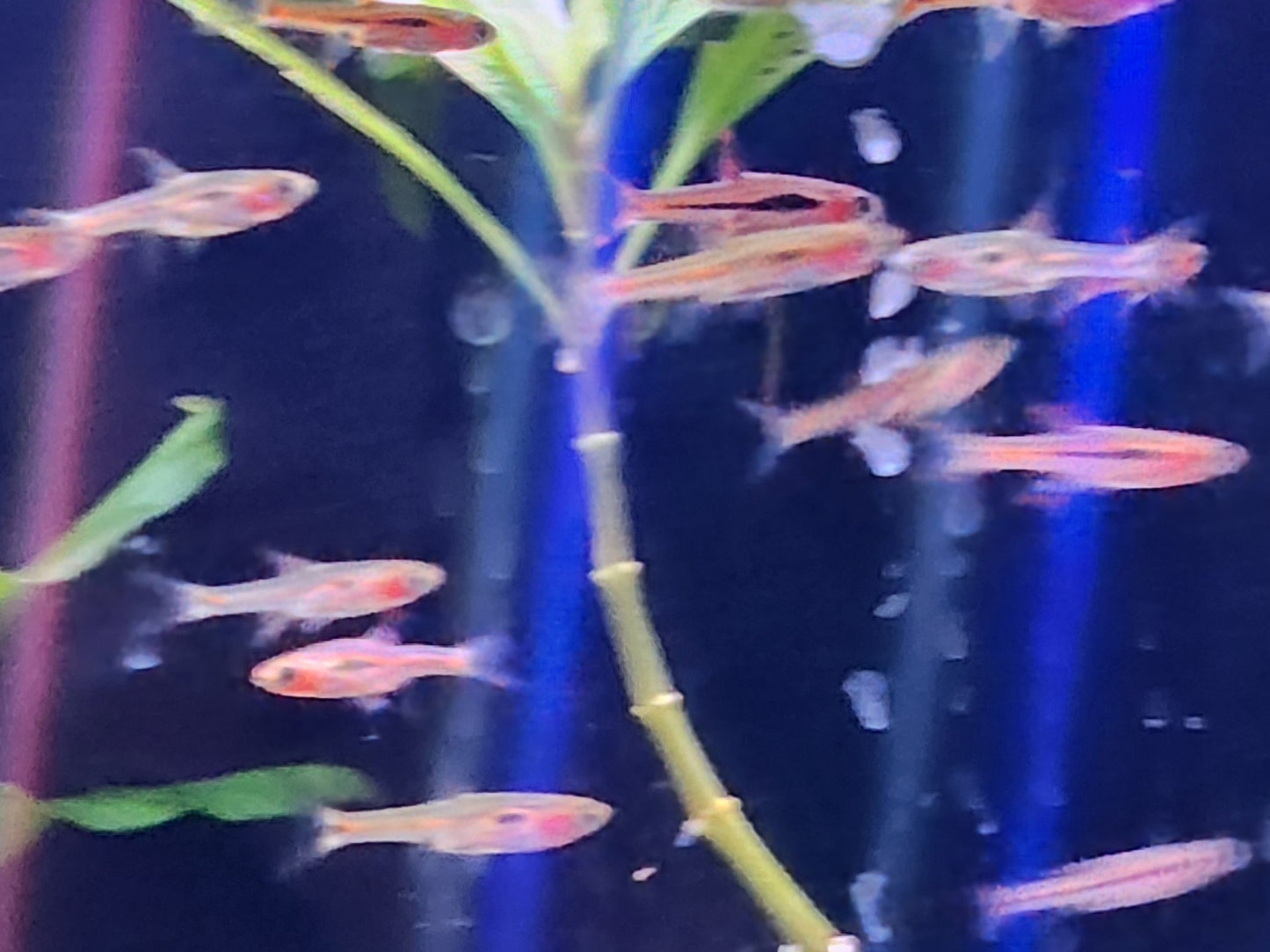Chili Rasbora
Chili Rasbora
25 in stock
Couldn't load pickup availability
To protect our animals and to ensure they get to our customers healthy and thriving, we will only ship our orders via UPS Next Day Air.
Size at shipping: 0.5 - 1" unsexed
The Chili Rasbora (Boraras brigittae) is a small, vibrant freshwater fish known for its striking coloration and peaceful nature. It’s a popular choice among aquarium enthusiasts, particularly in nano tanks, because of its small size and beautiful appearance. Here's everything you need to know about caring for Chili Rasboras:
1. Appearance:
-
Color: Chili Rasboras are well-known for their brilliant, red bodies with a subtle orange tint, and they have a distinct black line running horizontally through their body. The males typically exhibit more intense red coloration, especially when they're in good health or displaying to females.
-
Size: They are quite small, usually reaching a maximum size of around 1 inch (2.5 cm) in length, which makes them perfect for smaller aquariums.
-
Fins: They have relatively short fins, with the tail fin being somewhat pointed and the dorsal fin sitting closer to the back of the body.
2. Tank Requirements:
-
Tank Size: Because of their tiny size, Chili Rasboras do well in nano aquariums, and they can comfortably live in tanks as small as 5 gallons. However, it’s recommended to provide at least 10 gallons for a group of them.
-
Water Parameters:
-
Temperature: They prefer warmer water, ideally between 72°F to 80°F (22°C to 27°C).
-
pH: A slightly acidic to neutral pH range of 6.0 to 7.5 works best for them.
-
Hardness: Soft to medium hardness is ideal.
-
-
Filtration: They require clean, well-filtered water. Ensure the filter’s current isn’t too strong, as they prefer calm waters.
3. Diet:
-
Omnivorous Diet: Chili Rasboras are omnivores and will eat a variety of foods. In the wild, they feed on small invertebrates, zooplankton, and algae.
-
Aquarium Foods: In the aquarium, they can be fed high-quality flake food, micro pellets, and frozen or live foods like brine shrimp, daphnia, or infusoria. They will also graze on small amounts of algae and biofilm if available.
-
Feeding Frequency: Feed them small portions once or twice a day. Be sure to remove any leftover food to prevent water quality issues.
4. Behavior:
-
Peaceful and Social: Chili Rasboras are peaceful fish and do best when kept in groups of 6 or more. They are very social and will swim together in tight schools, often displaying bright colors when they feel secure or are courting each other.
-
Active and Curious: They are an active species, especially during the day. While they are generally peaceful, they are also very curious and will explore all corners of the aquarium.
-
Shy at First: Chili Rasboras can be a bit shy when first introduced to a new tank, but they will soon adapt to their environment if provided with plenty of hiding spots.
5. Tankmates:
-
Community Fish: Chili Rasboras are excellent for community tanks because they are peaceful and non-aggressive. They get along well with similarly sized, non-aggressive species like small tetras, Corydoras catfish, neon tetras, and other dwarf rasboras.
-
Avoid Larger Fish: Since they are so small, avoid keeping them with larger or more aggressive fish that may see them as prey. Species like bettas, angelfish, or larger cichlids may harass or eat them.
6. Breeding:
-
Egg Layers: Chili Rasboras are egg-layers, and breeding them in captivity is possible with the right conditions. A breeding tank with slightly acidic water and plants or spawning mats for the eggs is recommended.
-
Spawning Behavior: Males often show off their vibrant colors to attract females during breeding. After mating, the female will lay eggs, which will hatch in 24-48 hours.
-
Fry Care: The fry are tiny and will require infusoria or finely crushed food until they are large enough to eat regular fish food. It’s important to remove the adult fish after breeding to prevent them from eating the eggs or fry.
7. Maintenance and Care:
-
Water Quality: Chili Rasboras are sensitive to poor water quality, so regular water changes (20-30% per week) are essential to maintain their health.
-
Tank Setup: They prefer aquariums with plenty of plants, hiding places, and gentle water flow. Plants like Java moss, anubias, or cryptocoryne are excellent choices for a planted tank setup.
-
Lighting: They don’t require bright lighting, and soft, dim lighting works best, as it mimics their natural habitat and helps them feel secure.
8. Lifespan:
-
Chili Rasboras typically live around 3 to 5 years when kept in optimal conditions with good water quality and a proper diet.



